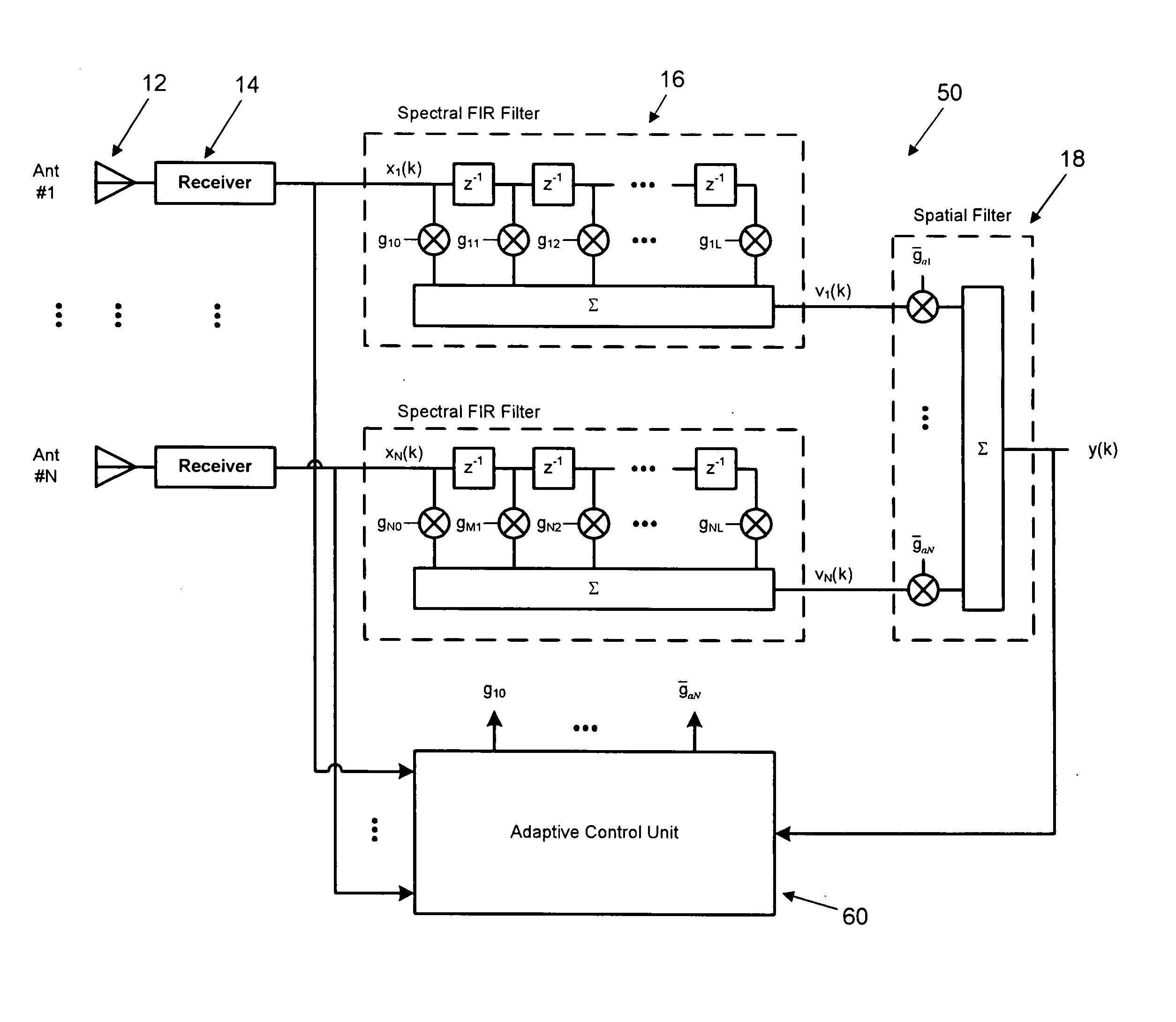Space / time / polarization adaptive antenna for ESM / ELINT receivers
a space/time/polarization and adaptive antenna technology, applied in direction finders using radio waves, polarisation/directional diversity, instruments, etc., can solve the problems of blocking the detection of desired signals that are near or within the bandwidth of the reject filter, wideband design, and completely inhibiting the detection of desired pulse signals. , to achieve the effect of suppressing high duty interference and high in-band interferen
- Summary
- Abstract
- Description
- Claims
- Application Information
AI Technical Summary
Benefits of technology
Problems solved by technology
Method used
Image
Examples
case 1
[0077] Case 1 involved only two signals, the SOI and one interfering signal at the same angle and frequency, but different polarizations. FIGS. 7 and 8 show the resulting antenna patterns for the SP-CMV and STP-CMV methods for the polarizations corresponding to the two signals. Note that both methods set the antenna gain to unity for the polarization and azimuth of the SOI as required by the constraint. Also, both methods produce nulls at the angle and polarization of the interfering signal. FIG. 9 shows the envelope of the beamformer output without adaptation and FIGS. 10 and 11 show the resulting signal envelope after adaptation for the two methods. Note that the STP-CMV method produces slightly better results.
case 2 adds
[0078] Case 2 adds interfering signal (#3 from Table 1) which is a wideband signal at a lower frequency (785 MHz), different azimuth angle (45 deg) and polarization (RHC). FIGS. 12 and 13 show the adapted pattern using the SP-CMV and STP-CMV methods for this signal set, and FIGS. 14 and 15 show the envelope of the adapted beamformer outputs. Note that while the SP-CMV produces a deeper null than the STP-CMV method at the azimuth of the added signal (i.e. 45 degrees), the envelope of the STP-CMV method shows much more suppression of the total interference. This demonstrates the improved capability that the FIR filters bring to the process.
case 3 adds
[0079] Case 3 adds another interfering signal (#4 from Table 1) to the signal environment. This signal is also a WBGN signal with a carrier frequency of 815 MHz, azimuth angle of 135 degrees and a slant left polarization. FIGS. 16 and 17 show the adapted antenna patterns for this signal set using the SP-CMV and STP-CMV methods, and FIGS. 18 and 19 show the resulting envelopes for the two techniques. Again, note the formation of a null at 135 degrees corresponding to the azimuth of the added signal. Also note that the envelope corresponding to the SP-CMV method is much degraded, indicating that it has reached its limit, while the envelope corresponding to the STP-CMV method still shows a signal-to-interference ratio (SIR) of nearly 30 dB.
PUM
 Login to View More
Login to View More Abstract
Description
Claims
Application Information
 Login to View More
Login to View More - R&D
- Intellectual Property
- Life Sciences
- Materials
- Tech Scout
- Unparalleled Data Quality
- Higher Quality Content
- 60% Fewer Hallucinations
Browse by: Latest US Patents, China's latest patents, Technical Efficacy Thesaurus, Application Domain, Technology Topic, Popular Technical Reports.
© 2025 PatSnap. All rights reserved.Legal|Privacy policy|Modern Slavery Act Transparency Statement|Sitemap|About US| Contact US: help@patsnap.com



